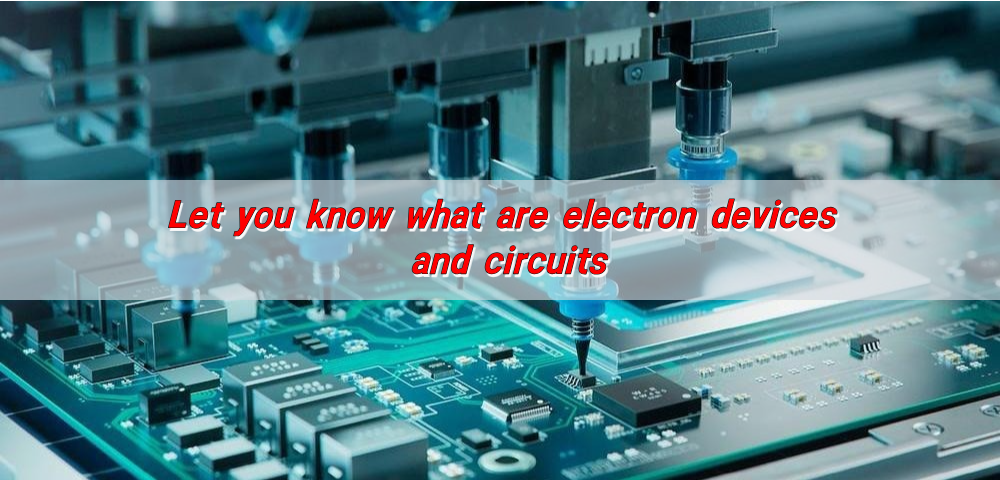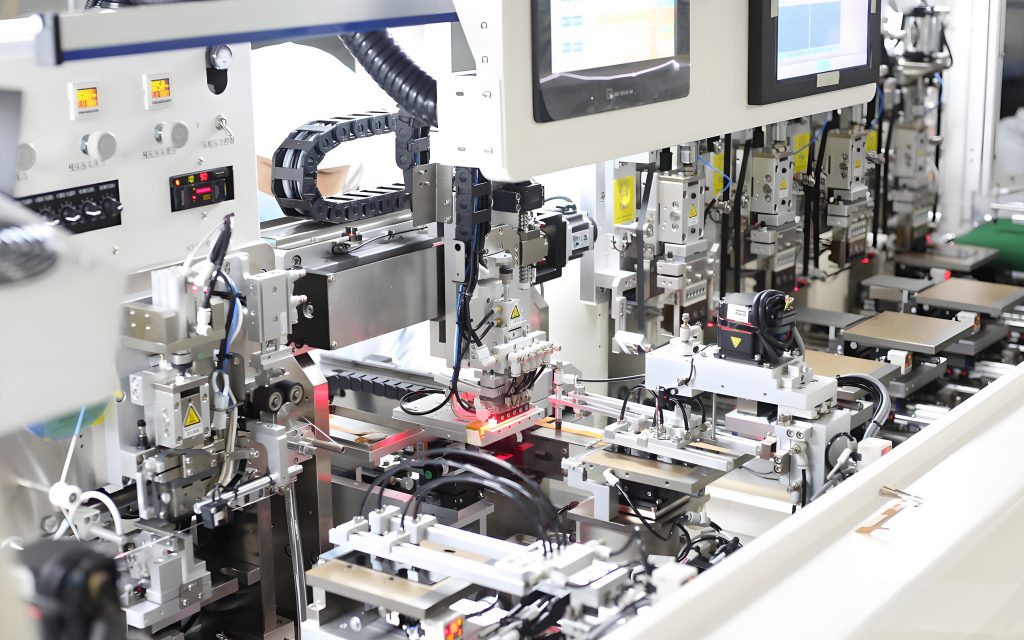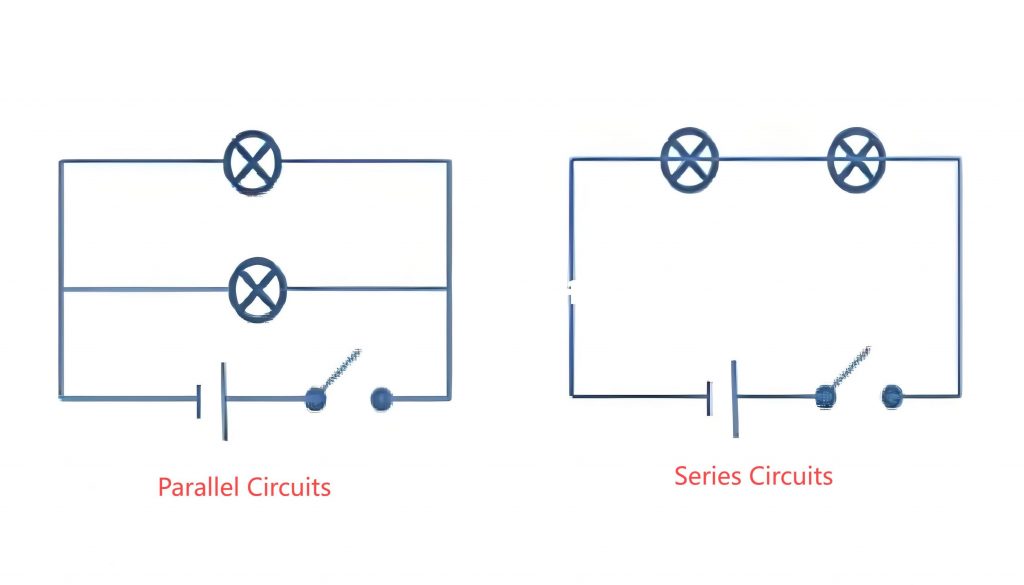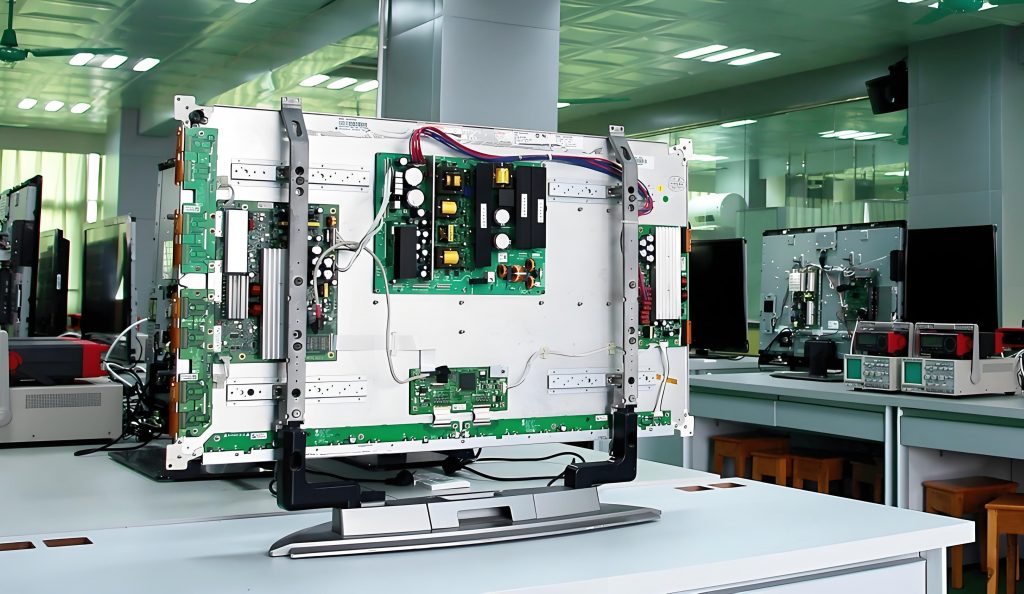Electron devices and circuits are the foundation of modern electronics. From smartphones and computers to medical scanners and satellite systems, these components quietly manage the flow of electricity behind the scenes. This blog explores how they work, what types exist, and how they power the electronic world around us.
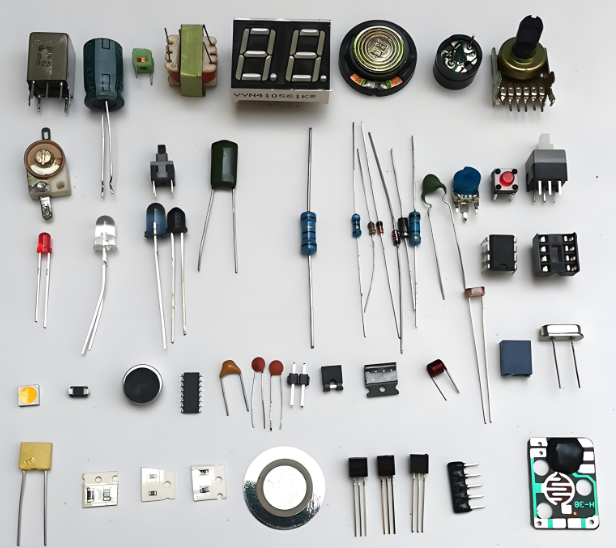
What Are Electron Devices?
Electron devices are components that either control, modify, or amplify electrical signals. These devices rely on the movement of electrons to function and are used in countless applications, from simple toys to complex industrial machinery. Their job is to manage electrical energy in ways that produce useful outputâsuch as turning on lights, processing data, or amplifying sound.
At their core, electron devices convert electrical energy into other forms or modify electrical signals to perform a specific function. Without them, modern electronic systems wouldn’t be possible.
Types of Electronic Devices
Each electronic component has specific properties that determine how it behaves in a circuit. The choice of components depends on the designerâs goal and the function the circuit is meant to perform. The image below highlights common electronic components used across various types of circuits. To better understand their roles, components are generally classified into two categories: Active Components and Passive Components.
1. Active Devices
Active devices can control current flow and even amplify weak electrical signals. These devices require an external power source to operate. Some common active devices include:
- Transistors: Used in amplifiers and switches.
- Diodes: Let current flow in one direction.
- Integrated Circuits (ICs): Tiny packages that contain complex electronic functions.
Active devices are central to any system that processes signals, computes information, or boosts communication signals.
2. Passive Devices
Passive devices do not generate energy. Instead, they store, dissipate, or transfer it. Common examples include:
- Resistors: Limit the flow of current.
- Capacitors: Store and release electrical energy.
- Inductors: Resist sudden changes in current.
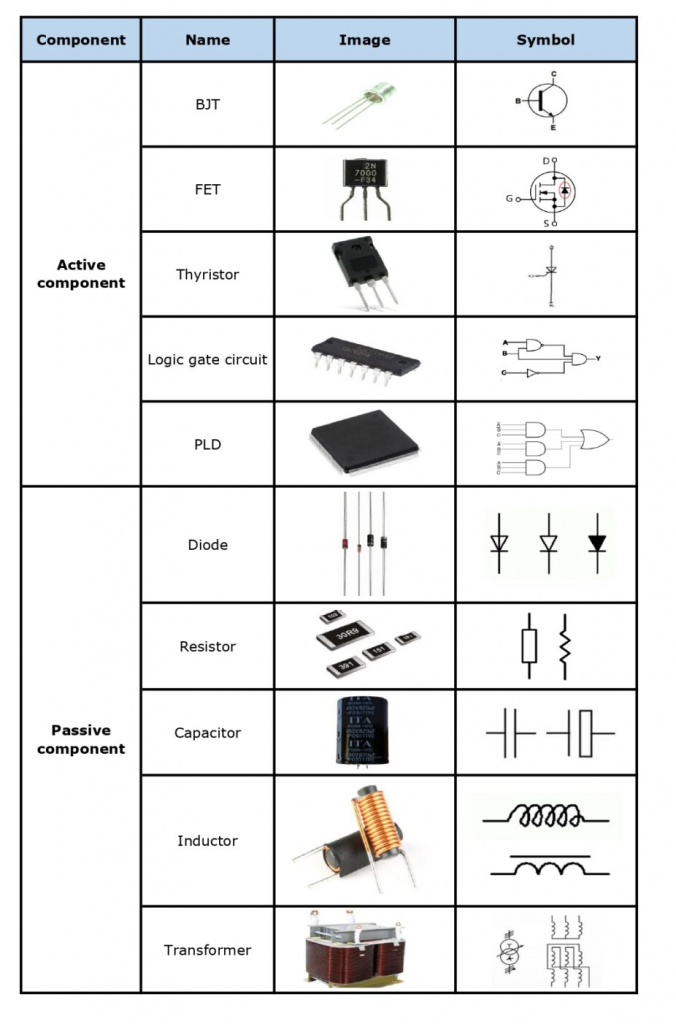
These components support the work of active devices and help shape how signals behave in a circuit.
What Are the 5 Basic Electronic Devices?
The five basic devices youâll find in nearly every circuit are:
- Resistor
Resistors manage the current flowing through different parts of a circuit. They help in dividing voltage, controlling signal levels, and protecting components from excessive current.
- Capacitor
Capacitors store electrical charge temporarily. Theyâre used in filtering noise, smoothing power supply outputs, and creating time delays.
- Inductor
Inductors store energy in a magnetic field when current flows through them. Theyâre commonly used in filters, power supplies, and transformers.
- Diode
Diodes allow current to flow in only one direction. They are essential in power rectification, signal demodulation, and voltage regulation.
- Transistor
Transistors act as switches or amplifiers. They control the flow of current and are fundamental to logic circuits and digital electronics.
How Do Electronic Devices Work?
Each electronic device has a specific function based on its physical and electrical characteristics:
- Resistors slow down current.
- Capacitors store energy in an electric field.
- Inductors build magnetic fields.
- Diodes control direction.
- Transistors regulate and amplify signals.
Together, these devices shape how electricity behaves inside a circuit. When connected in specific arrangements, they form circuits capable of performing tasks like amplifying a sound, storing digital information, or controlling a motor.
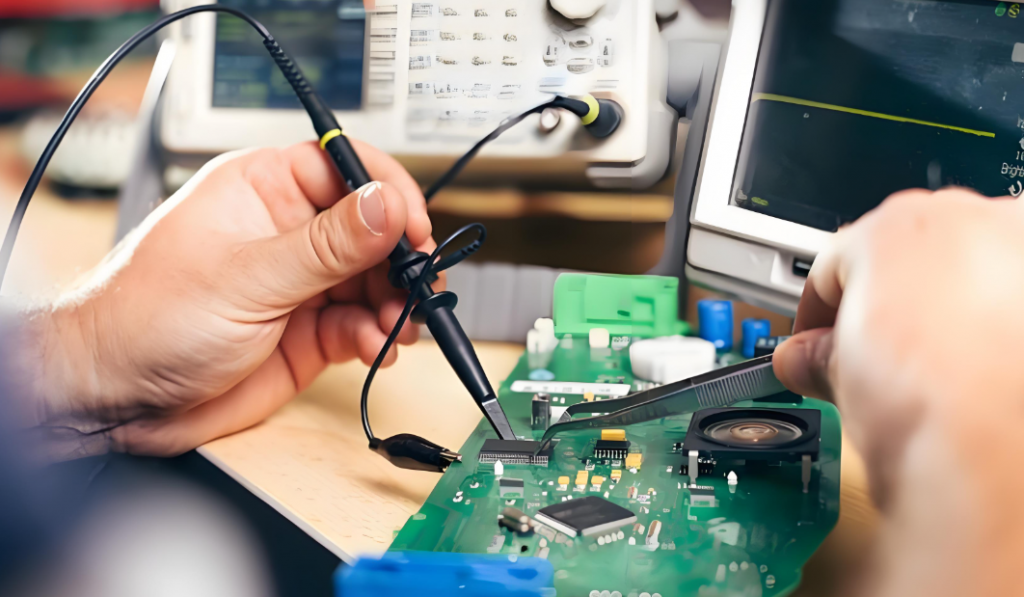
What Are Electronic Circuits?
An electronic circuit is a system of connected components that guide electrical currents to perform a specific job. These circuits can be as simple as a battery lighting an LED or as complex as the logic boards inside a computer.
Circuits make electronic devices work by controlling where and how electricity flows. Each component in the circuit has a roleâsome store energy, others shape signals, and some respond to external inputs like light or sound.
Types of Electronic Circuits
Electronic circuits come in a few major types, depending on how they handle signals:
- Analog Circuits
Analog circuits work with continuous signals. They are used in audio systems, radio receivers, and temperature sensors. They process real-world inputs like sound or light.
- Digital Circuits
Digital circuits work with binary signals (0s and 1s). They form the backbone of computers, smartphones, and digital watches. Logic gates and microcontrollers are key components.
- Mixed-Signal Circuits
These combine analog and digital elements. Examples include digital audio converters, embedded controllers, and power management circuits.
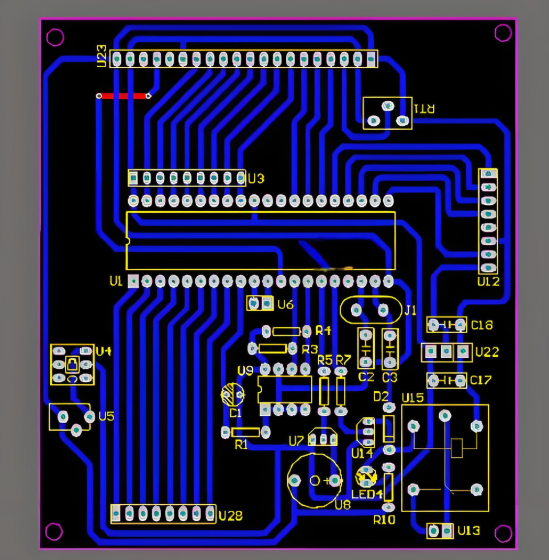
Key Components in Electronics Circuits
A functioning circuit depends on a combination of components, each with a distinct role:
- Power Supply: Provides the necessary voltage and current.
- Resistors: Manage current flow and protect sensitive parts.
- Capacitors & Inductors: Shape or filter signals and manage timing.
- Diodes & Transistors: Control signal direction, switching, and amplification.
- Integrated Circuits (ICs): Combine multiple components in one small package for complex functions.
- Switches, Connectors & PCBs: Physically support and route current throughout the system.
All these parts are arranged on a printed circuit board (PCB), which provides the mechanical structure and electrical connections.
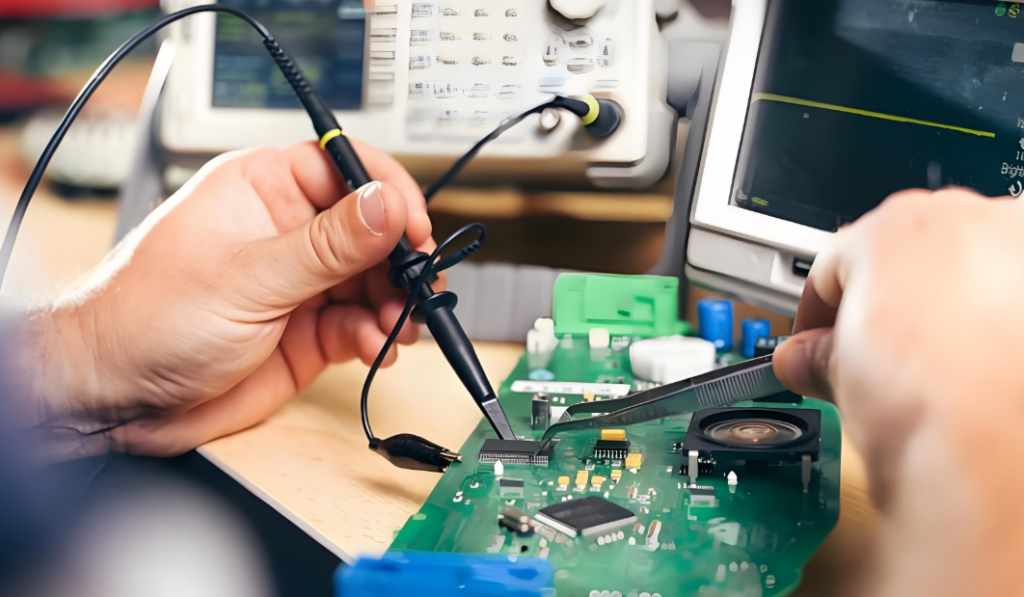
How to Design an Electronic Circuit?
Designing a circuit starts with a clear goal. Once the purpose is defined, follow these steps:
- Outline Your Requirements: What do you want the circuit to do?
- Create a Schematic: Use circuit design software to build the layout using symbols for each component.
- Select Components: Choose values for resistors, capacitors, etc., based on your requirements.
- Simulate the Circuit: Check how it behaves using tools like LTspice or Proteus.
- Build a Prototype: Use a breadboard or PCB to assemble and test your design.
- Test & Debug: Measure voltages and currents to confirm it works as expected.
- Final Layout: Once tested, you can design a PCB for the final version.
Even simple circuits need careful planning, as incorrect wiring or value choices can lead to failure or inefficiency.
Common Measurement Devices for Electronic Circuits
To check and troubleshoot circuits, engineers use various tools:
- Multimeter: Measures voltage, current, and resistance. Essential for almost any testing.
- Oscilloscope: Displays how signals change over timeâhelpful for analyzing waveforms.
- LCR Meter: Measures inductance (L), capacitance (C), and resistance (R).
- Logic Analyzer: Helps in debugging digital signals and timing issues.
These devices ensure that the circuit performs properly under different conditions.
Applications of Electron Devices and Circuits
Electron devices and circuits power virtually all technology we use today. Here are a few major application areas:
- Consumer Electronics: Televisions, phones, game consoles, and home appliances all rely on sophisticated circuits.
- Automotive Systems: Used in engine control units (ECUs), ABS brakes, GPS modules, and more.
- Medical Devices: Circuits manage everything from heart monitors to imaging systems.
- Telecommunications: Signal boosters, routers, and network devices depend on electronic components.
- Industrial Equipment: Used in automation, robotics, and machine control systems.
- Defense & Aerospace: Critical in radar systems, flight control computers, and satellite communications.
No matter the industry, the role of electron devices and circuits is critical in innovation, performance, and safety. Whether you’re a student, hobbyist, or professional, grasping how circuits function and how devices interact is essential to designing or repairing electronic equipment.
For those looking to build reliable circuit boards or need help bringing their electronic designs to life, partnering with an expert manufacturer is key.
Why Choose Best Technology for Electronic Circuit Projects?
Best Technology is a trusted PCB manufacturer specializing in both prototype and volume production. With ISO-certifications, our team ensures your circuits meet international standards. Whether you need rigid PCBs, flexible circuits, or mixed-signal board assemblies, we help turn your ideas into high-quality productsâon time and within budget. By choosing Best Technology, you can enjoy:
1. Fast Turnaround from Prototype to Mass Production
We help you move quickly from design to final product. Whether it’s a first-run prototype or a full production batch, we adapt to your schedule and keep your project on track.
2. Hands-On Engineering Support
Our experienced engineers work with you on component selection, stack-up optimization, and layout suggestionsâhelping you avoid design flaws before production begins.
3. High Customization, No Fear of Complexity
Need a non-standard stack-up, hybrid materials, or bendable structures? We handle complex builds with confidence and tailor every detail to match your design requirements.
4. Clear Quotes and On-Time Delivery
Our pricing is transparent, and our timelines are realistic. Dedicated project coordinators provide regular updates, so you’re never left guessing.
5. Quality is a Daily Practice, Not Just a Promise
We donât just inspect a few boardsâwe test every unit. From flying probe tests to X-ray and AOI, our quality process ensures every board performs reliably.
FAQs
1. Whatâs the difference between an electronic and electrical device?
Electronic devices use the flow of electrons to process signals, while electrical devices typically handle power distribution and energy conversion.
2. Can I build electronic circuits without a PCB?
Yes, prototypes are often built on breadboards or perfboards, but PCBs are used for stability and durability in final products.
3. What software is best for circuit design?
Popular tools include KiCad, Eagle, Altium Designer, and Proteus for simulation and layout.
4. What is the most common cause of circuit failure?
Overheating, poor soldering, incorrect component values, or voltage surges are common failure causes.
5. How do I start learning electronics as a beginner?
Start with basic components, build simple circuits using breadboards, and gradually move to microcontroller projects using kits like Arduino or Raspberry Pi.



